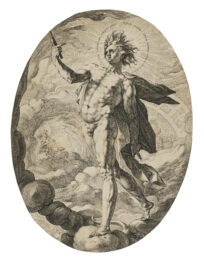

German printmaker, painter and draughtsman Hendrik Goltzius was born in 1558 in what was then known as the North Rhine-Westphalia. He was one in a long line of artists; his father, grandfather and great-grandfather were all also artists. Goltzius was one of the outstanding figures of the Dutch artworld in the 15th and 16th centuries; known for his sophisticated Mannerist engraving techniques within the early Baroque period, although he did start to produce paintings in the Middle Ages. He received international acclamation for his work, with esteemed patrons such as the notorious art lover Holy Roman Emperor Rudolph II.
Goltzius produced graphic art using innovative media such as chalk, metal point and brush and ink. He stood out from his peers by creating large, monochromatic pieces that featured extensive detail. He turning more towards painting from 1600, for two possible reasons. Firstly, it was asserted that his eyesight was failing and he could no longer create highly detailed works. Secondly, that a visit from Rubens in 1612 had inspired Goltzius to change into a more classical style. His masterpiece was the Danaë, which can now be found in the Los Angeles County Museum of Art. Hendrik Goltzius died aged 58, in Haarlem.